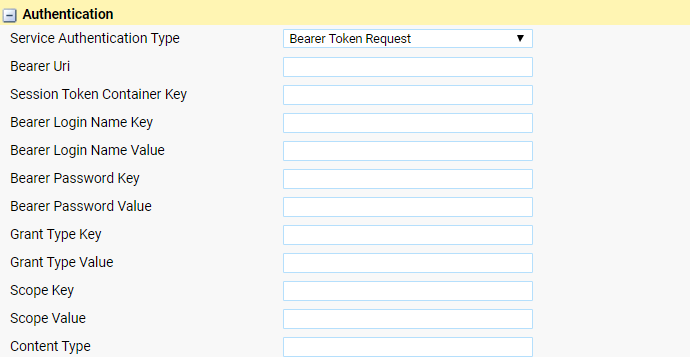The authentication can be done in six ways:
1.None
2.Basic
3.Bearer
4.Bearer token request
5.Claims
6.HTTP Header token
Select the authentication type required by the service provider
None
Option 1 does not require any configuration but is not secure in any way.
Basic Authentication

Figure 16, Create a Service Provider - step 4 - Basic Authentication
Attribute |
Explanation |
Authentication Code |
Code when third party uses basic Authentication |
Authentication Password |
Password when basic authentication is used. |
Bearer Authentication

Figure 17, Create a Service Provider - step 4 - Bearer Authentication
Attribute |
Explanation |
Bearer Provider Id |
Provider Id |
Bearer Auth Token |
Authentication token |
Bearer Token request Authentication
The Bearer Token Request authentication configuration provides the user with a way to utilize modern OAuth2 service communication security. This configuration allows the user to connect to the contemporary services, which require this new type of authentication. In case of Bearer Token Request authentication, the API call consists of two parts. First, the application calls the service to acquire the Bearer Token. Next, the acquired token is used for the authentication of the following call to obtain or transfer the necessary data.

The information below shall be provided by the provider
Attribute |
Explanation |
Bearer Uri |
Address to the provider |
Session Token Container Key |
The name of the message attribute, containing the Token |
Bearer Login Name Key |
Login Name attribute name. E.g. “login”, “email”, “username” etc. |
Bearer Login Name Value |
User’s login name value with the service |
Bearer Password Key |
Password attribute name. E.g. “password”, “secret” etc. |
Bearer Password Value |
The actual user’s password |
Grant Type Key (optional) |
The name of the Grant type attribute |
Grant Type Value (optional) |
The actual value of the Grant type |
Scope Key (optional) |
The name of the Scope attribute |
Scope Value (optional) |
The actual value of the Scope attribute |
Content Type |
The type of the message content required by the service E.g. “application/json”, “application/x-www-form-urlencoded” etc. |
Claims Authentications

Figure 18, Create a Service Provider - step 4 - Claims Authentication
Attribute |
Explanation |
Claims Wrap Endpoint (Acquire) |
|
Claims Wrap Scope (Realm) |
|
Claims Wrap Issuer |
|
Claims Wrap Signing Key |
|
HTTP Header Token Authentications

Attribute |
Explanation |
HTTP Header name |
The name in the Header attribute/element |
HTTP Header Value |
The value of the attribute/element |